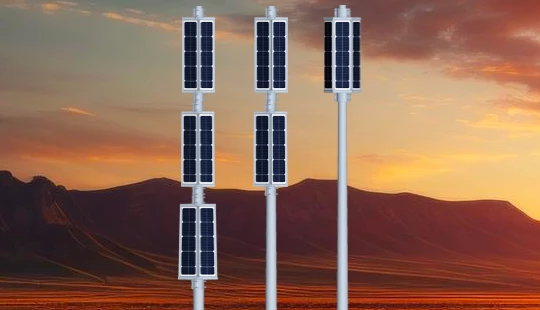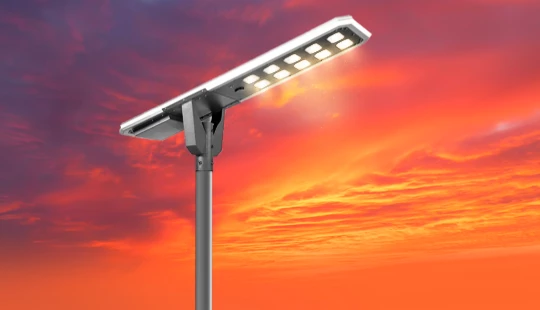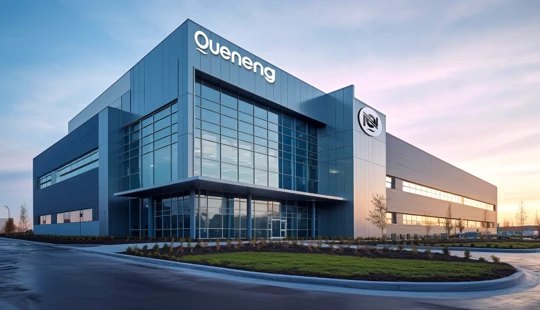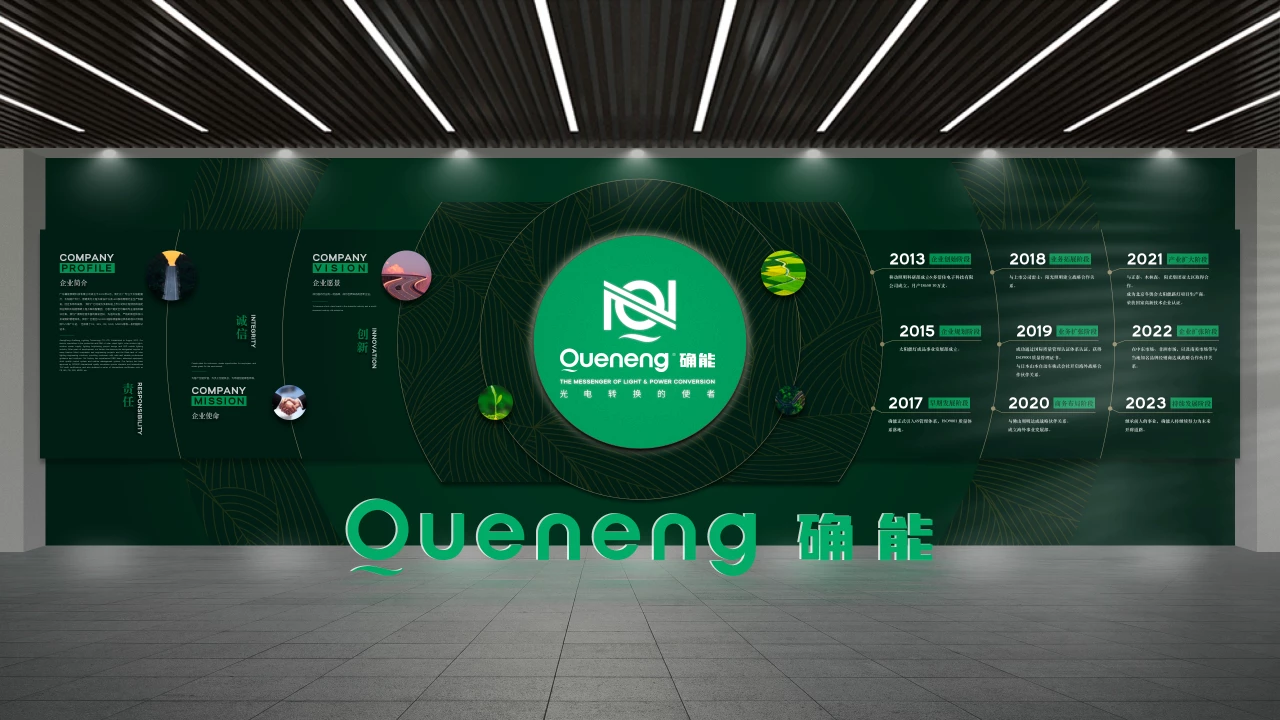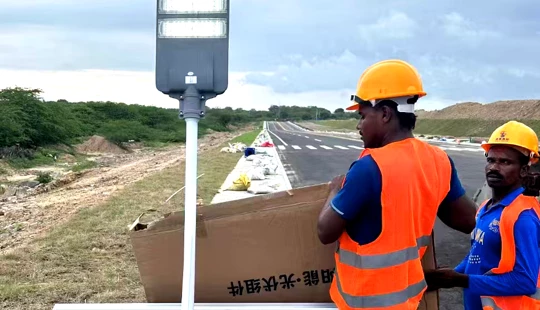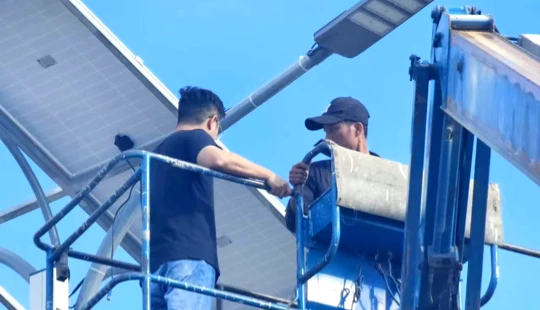OEM solar lights Jordan | Insights by Quenenglighting
<h2>Navigating OEM Solar Lights in Jordan: Your Procurement Guide</h2><p>Jordan is rapidly embracing renewable energy, with solar power at the forefront of its sustainable development initiatives. For businesses, municipalities, and developers, the demand for reliable and efficient solar lighting solutions is on the rise. Opting for Original Equipment Manufacturer (OEM) solar lights provides the flexibility for customization, quality control, and cost-effectiveness essential for large-scale projects. This guide will walk you through the critical aspects of procuring OEM solar lights specifically for the Jordanian market, addressing common questions and professional considerations.</p><h3>1. Tailoring Solar Lights: Essential Specifications for Jordan's Climate</h3><p>Jordan’s climate, characterized by high temperatures, intense solar radiation, and dusty conditions, necessitates specific design considerations for solar lights to ensure longevity and optimal performance. When procuring OEM solar lights, pay close attention to:</p><ul> <li><strong>IP Rating:</strong> For outdoor use in dusty environments, an Ingress Protection (IP) rating of IP65, IP66, or even IP67 is crucial to protect against dust ingress and water jets or temporary immersion.</li> <li><strong>Battery Technology:</strong> Lithium Iron Phosphate (LiFePO4) batteries are highly recommended. They offer superior cycle life (typically 2000-4000+ cycles), better thermal stability at high temperatures compared to lead-acid or other lithium-ion chemistries, and a longer lifespan (up to 10 years).</li> <li><strong>Solar Panel Efficiency:</strong> Monocrystalline silicon solar panels are generally more efficient (18-22% efficiency commonly available) and perform better in low-light conditions and higher temperatures than polycrystalline panels, maximizing energy harvesting.</li> <li><strong>Charge Controller:</strong> An MPPT (Maximum Power Point Tracking) charge controller is vital. It optimizes the power output from the solar panel, increasing charging efficiency by 15-30% compared to PWM controllers, especially under varying sunlight conditions.</li> <li><strong>Operating Temperature Range:</strong> Ensure the entire system, including LED driver and battery, is rated to perform reliably within Jordan’s extreme temperature fluctuations, from hot summers to cold desert nights.</li></ul><h3>2. Ensuring Quality & Durability: Key Checks for Your OEM Partner</h3><p>Quality assurance is paramount for OEM solar lights, as they represent a long-term investment. Here’s how to ensure the reliability of your products:</p><ul> <li><strong>Certifications:</strong> Verify that the manufacturer and their products hold relevant international certifications such as CE, RoHS, FCC, and ISO 9001 (for quality management systems) and ISO 14001 (for environmental management). These indicate adherence to international standards and best practices.</li> <li><strong>Material Quality:</strong> Inquire about the quality of components used – from the LED chips (e.g., Philips, Cree, Osram) and drivers to the aluminum alloy or galvanized steel for poles and casings. High-grade materials resist corrosion and degradation.</li> <li><strong>Manufacturing Process & QC:</strong> A reputable OEM partner will have stringent Quality Control (QC) protocols at every stage, from incoming raw material inspection to in-process checks and final product testing (e.g., aging tests, vibration tests, light distribution tests in integrating spheres).</li> <li><strong>Warranty & After-Sales Support:</strong> A comprehensive warranty (typically 3-5 years for the entire system and 10-25 years for solar panels) and a clear policy for spare parts and technical support are non-negotiable for long-term peace of mind and maintenance.</li></ul><h3>3. ROI & Cost-Effectiveness: A Smart Investment in Jordanian Infrastructure</h3><p>Investing in OEM solar lighting offers significant long-term returns, especially in regions with high electricity costs or limited grid access like parts of Jordan. While initial setup costs might seem higher than traditional lighting, consider the following:</p><ul> <li><strong>Zero Electricity Bills:</strong> Once installed, solar lights operate entirely independent of the grid, eliminating recurring electricity costs. This is a substantial saving over their operational lifespan.</li> <li><strong>Reduced Installation Costs:</strong> Without the need for trenching, wiring, and grid connections, installation is faster and less labor-intensive, particularly for new developments or remote areas.</li> <li><strong>Low Maintenance:</strong> Modern solar lights require minimal maintenance, primarily limited to occasional cleaning of solar panels and battery checks. The long lifespan of LiFePO4 batteries (8-10 years) and LEDs (50,000+ hours) further reduces operational expenses.</li> <li><strong>Government Incentives:</strong> Explore any current Jordanian government incentives or tax breaks for renewable energy projects, which can further enhance your Return on Investment (ROI). While specific active incentives vary, Jordan has shown strong commitment to solar energy development.</li> <li><strong>Declining Technology Costs:</strong> The global cost of solar technology has seen a significant decline over the last decade (e.g., solar panel costs have decreased by over 80% since 2010), making solar lighting more accessible and cost-effective than ever before.</li></ul><h3>4. Seamless Procurement: Logistics & Import for OEM Solar Lights to Jordan</h3><p>Navigating the logistics of importing OEM solar lights into Jordan requires careful planning to avoid delays and unforeseen costs:</p><ul> <li><strong>Incoterms:</strong> Clearly define Incoterms (e.g., FOB, CIF, EXW) with your OEM supplier to specify responsibilities for shipping costs, insurance, and customs clearance. For bulk orders, FOB (Free On Board) is common, where the buyer takes responsibility once goods are on the vessel.</li> <li><strong>Customs Regulations:</strong> Research current Jordanian import duties, tariffs, and regulations for solar power equipment. Stay updated, as policies can change. Work with a knowledgeable local customs broker.</li> <li><strong>Lead Times:</strong> Factor in production lead times (which can vary from 4-8 weeks for OEM orders depending on complexity and volume) plus shipping time (e.g., 2-4 weeks by sea from Asia) to meet your project deadlines.</li> <li><strong>Packaging:</strong> Ensure the OEM uses robust, export-grade packaging suitable for long-distance international shipping to prevent damage to sensitive components like solar panels and batteries.</li> <li><strong>Documentation:</strong> Verify all necessary shipping documents (commercial invoice, packing list, bill of lading, certificate of origin, test reports) are correctly prepared and provided by the supplier to facilitate smooth customs clearance.</li></ul><h3>5. Smart Solar: Integrating IoT & Advanced Features for Optimal Performance</h3><p>Modern OEM solar lighting goes beyond basic illumination. Integrating smart features can significantly enhance efficiency, control, and management:</p><ul> <li><strong>Remote Monitoring & Control:</strong> IoT-enabled solar lights can be monitored and controlled remotely via a central platform or mobile app. This allows for real-time status checks, energy consumption monitoring, and troubleshooting without on-site visits, significantly reducing O&M costs.</li> <li><strong>Adaptive Lighting:</strong> Features like motion sensors or timed dimming automatically adjust brightness based on presence or time of night, conserving energy and extending battery life. For example, a light might dim to 30% power during off-peak hours and brighten to 100% upon detecting movement.</li> <li><strong>Centralized Management:</strong> For large-scale projects (e.g., street lighting networks), a smart management system allows for grouping lights, scheduling lighting profiles, and receiving alerts for malfunctions, optimizing entire networks.</li> <li><strong>Data Analytics:</strong> Smart systems can collect valuable data on energy usage, battery health, and operational patterns, providing insights for predictive maintenance and further optimization.</li></ul><h3>Quenenglighting: Your Advantage in OEM Solar Solutions for Jordan</h3><p>When sourcing OEM solar lights for your projects in Jordan, partnering with an experienced and reliable manufacturer like Quenenglighting offers a distinct advantage. Quenenglighting stands out with its commitment to:</p><ul> <li><strong>Customization Excellence:</strong> We specialize in tailored OEM solutions, designing solar lights that precisely meet your project’s specifications, environmental requirements for Jordan, and aesthetic preferences.</li> <li><strong>Uncompromising Quality:</strong> Utilizing top-tier components (e.g., high-efficiency monocrystalline panels, long-life LiFePO4 batteries, reputable LED chips) and adhering to rigorous ISO-certified manufacturing and QC processes, Quenenglighting ensures durable and high-performing products.</li> <li><strong>Advanced Technology Integration:</strong> Our products incorporate the latest innovations, including MPPT controllers and optional IoT smart features for remote monitoring and adaptive lighting, ensuring your investment is future-proof.</li> <li><strong>Competitive Value:</strong> By optimizing our supply chain and manufacturing efficiency, we deliver cost-effective solutions without compromising on quality, ensuring a strong ROI for your project.</li> <li><strong>Comprehensive Support:</strong> From initial design consultation and technical support to reliable logistics and after-sales service, Quenenglighting provides a seamless procurement experience, ensuring your solar lighting project in Jordan is a resounding success.</li></ul><p>Choose Quenenglighting for a partnership that illuminates Jordan's future with sustainable, high-quality, and intelligently designed OEM solar lighting solutions.</p>
Have more questions about our products or services?
The latest hot news you might like

Discover how solar panels power street lights, exploring the technology behind solar energy conversion, storage systems, and how solar-powered street lights are revolutionizing urban and rural lighting solutions.

Learn how AC Solar Hybrid Street Lights work, their advantages, disadvantages, system behavior in low-sunlight conditions, and why hybrid technology is ideal for regions with unstable sunlight.

Municipalities around the world are increasingly adopting solar-powered streetlights as part of their urban development strategies. Rising energy costs, the need for sustainable infrastructure, and government green initiatives are driving cities to switch from traditional street lighting to advanced LED solar streetlights.
Queneng Lighting provides municipalities with cost-effective, energy-efficient, and durable solar lighting solutions, ensuring safe and sustainable public spaces.
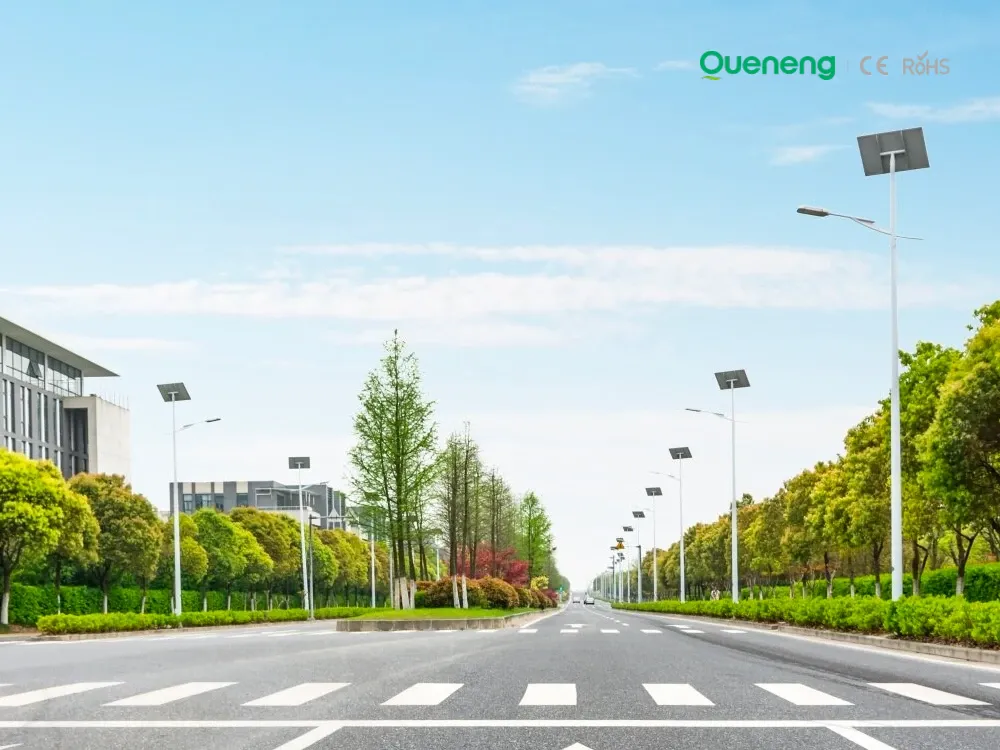
In recent years, the purchase of solar streetlights for municipalities has become a growing trend across the globe. Local governments are under pressure to reduce public expenditure, promote green energy, and create safer communities. Solar streetlights provide a reliable, cost-effective, and sustainable solution that meets these needs. Queneng Lighting, as a leading solar street lighting manufacturer, has supported multiple municipal projects worldwide with customized and energy-efficient solutions.
FAQ
Solar Street Light Luyan
What types of batteries are used in Luyan solar street lights, and how do they work?
Luyan solar street lights use high-quality lithium-ion batteries. These batteries store the solar energy captured during the day and provide reliable illumination at night. Lithium-ion batteries are known for their longer lifespan, faster charging times, and better energy storage compared to traditional lead-acid batteries.
Sustainability
If the light or battery fails, can it be replaced individually?
Yes. Queneng’s solar street lights are designed with a modular structure, so components such as photovoltaic panels, batteries, lights, and controllers can be replaced individually, making maintenance convenient and cost-effective.
Battery Types and Applications
What is a smart secondary battery?
What are the voltages and usage areas of different types of batteries?
Lithium battery 6V camera, etc.
Lithium manganese button battery 3V pocket calculator, watch, remote control equipment, etc.
Silver oxygen button battery 1.5V watches, small clocks, etc.
Carbon manganese round battery 1.5V portable video equipment, cameras, game consoles, etc.
Carbon manganese button battery 1.5V pocket calculator, electric equipment, etc.
Zinc carbon round battery 1.5V alarm, flash light, toys, etc.
Zinc air button battery 1.4V hearing aids, etc.
MnO2 button battery 1.35V hearing aids, cameras, etc.
Nickel-cadmium battery 1.2V power tools, mobile phones, notebooks, emergency lamps, electric bicycles, etc.
Ni-MH battery 1.2V mobile phones, portable cameras, cordless phones, notebooks, household appliances, etc.
Lithium-ion battery 3.6V mobile phones, notebook computers, etc.
Battery Performance and Testing
What is trickle charging?
Batteries and the environment
How do used batteries pollute the environment?


Queneng's Luzhou Solar Street Light provides sustainable, energy-efficient outdoor LED lighting. Powered by solar energy, it's a cost-effective and eco-friendly solution for illuminating streets and pathways. A reliable and durable LED solar street light.

Discover the Lulin High-Performance Solar Street Light by Queneng, a durable and energy-saving outdoor lighting solution. Designed for efficiency and reliability, it harnesses solar power to sustainably illuminate streets and pathways. Optimize your outdoor spaces today with Queneng's innovative solar street lighting technology.

Illuminate your outdoor spaces with the Solar Street Light, a cutting-edge solution combining advanced solar technology and energy-saving LED lighting.

The Solar Streetlights of Luhao for Municipalities are designed to deliver reliable, energy-efficient, and cost-effective public lighting solutions. Equipped with advanced LED technology, durable lithium batteries, and high-efficiency solar panels, these streetlights provide consistent illumination for roads, parks, residential areas, and government projects.

If you would like more information about Queneng solar lighting solutions, please send us a message by filling out the form below. Our professional team will get back to you within 24 hours!
Rest assured that your privacy is important to us, and all information provided will be handled with the utmost confidentiality.
Schedule a Meeting

Book a date and time that is convenient for you and conduct the session in advance.
Have more questions about our products or services?

